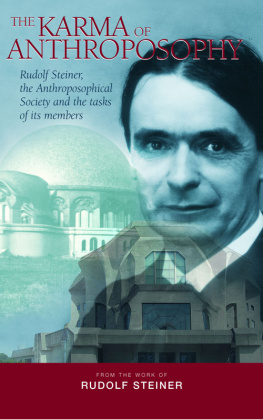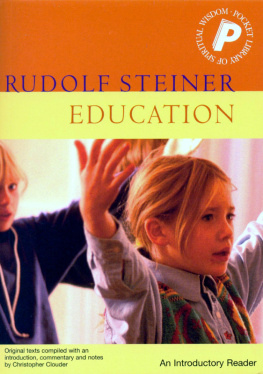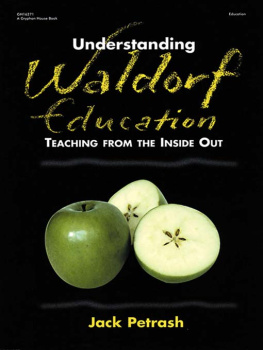AN INTRODUCTION TO
STEINER EDUCATION
AN INTRODUCTION TO
STEINER EDUCATION
The Waldorf School
Francis Edmunds
Sophia Books
Sophia Books
Hillside House, The Square
Forest Row, RH18 5ES
www.rudolfsteinerpress.com
Published by Sophia Books 2012
An imprint of Rudolf Steiner Press
First published in 1979, and reissued 1982, 1986, 1987, 1992.
This edition has been edited, revised and updated by Matthew Barton
Rudolf Steiner Press 2012
The moral right of the author has been asserted under the Copyright,
Designs and Patents Act, 1988
All rights reserved. No part of this publication may be reproduced, stored
in a retrieval system, or transmitted, in any form or by any means,
electronic, mechanical, photocopying or otherwise, without the prior
permission of the publishers
A catalogue record for this book is available from the British Library
ISBN 978 1 85584 271 7
Cover by Andrew Morgan Design
Typeset by DP Photosetting, Aylesbury, Bucks.
CONTENTS
Foreword
by Martyn Rawson
It is twenty-five years since Francis Edmunds first published this book, and the Steiner Waldorf Schools movement has changed in many ways in this past quarter century. In view of this it would be justified to ask if such a book is still relevant? What is in many ways more significant is the fact that the world has changed in this time in ways that very few people could have predicted and it is these changes that pose the question: is Steiner Waldorf education itself still relevant?
I started teaching about the time that this book was written. As a visiting student I had experienced Francis at Emerson College. For many of us he was already an almost mythical figure, one who represented an inspiring image of wisdom, genius, mystery and charismathe very qualities we intuitively associated with the Waldorf Class teacher. As a young man with a young family and a serious task in the world (founding a Waldorf school), a figure like Francis Edmunds was not only an inspiration but a standard one measured oneself against. It is not that one tried to be like him, but one experienced qualities in him that one felt were necessary to cultivate.
There were others among that group of outstanding personalities of his generation from whom we learned and drew courage. Edmunds, though, had a curious aura. He appeared to have a personal following quite unusual in Waldorf circles. Even today I frequently meet people all over the world who almost immediately on hearing of my work in Forest Row tell me of their time at Emerson College and their memories of Francis (Asian people always say Mr Edmunds of course). It seems like it was a golden time for a whole generation of young people who are now leading lights in the international Waldorf School movement. And that seems to be the crucial pointEdmunds and Emerson College brought Waldorf education to the world in a way that was unique. Something of that uniqueness is apparent in this book. Francis Edmunds had the ability to make complex ideas seem comprehensible. He was a great communicator. The ideas underlying Waldorf education can be very hard to grasp. There are many learned books explaining anthroposophy that frankly are barely comprehensible (though few would admit it). Francis lived these ideas and was interested in helping others find their way into them too. This was a great achievement and one that has left a lasting impression on the international Waldorf School movement. Curiously, though, his books have not translated well in German and other languages. For the German ear, Francis seemed lightweight. He wasnt.
Many countries now have their own teacher training programmes, but in those days Emerson was a beacon for Waldorf Education through the English language and as such offered a counterbalance to the German speaking Waldorf centres in Dornach (Switzerland) or Stuttgart. Scandinavia had Jarna, the Dutch had Zeist, but the world had Emerson College!
The world but not necessarily Great Britain. Of course many British students did learn to be teachers at Emerson College, but most years they have been in a minority. Emerson College and Francis Edmunds had their greatest influence locally in Forest Row, that quiet backwater in the stockbroker belt south of London, and in the wider world. For many of us in the British Waldorf schools movement, Emerson College was as remote as Dornach or Jarna. This curious situation, which had many explanatory factors not relevant here, tells us however something very positive about Francis Edmunds. His understanding and demonstration of Waldorf education was most brilliant when he addressed what is universally human. It is that dimension of universality that graces both the best in this book and which ultimately makes Waldorf education relevant in a much changed world.
What is the challenge of education in our times? The answer in a word is globalization. This concept includes not only the shift in the global economy away from the industrial Western nations but the cultural impact of the electronic media. Twenty-five years ago the world had a very different economic and political structure. Now the Berlin Wall has fallen and the Soviet Empire has gone, major parts of the Second and Third Worlds, such as India, China and Indonesia, are rapidly developing and becoming the manufacturing powerhouses of the world economy. Multinational consortia and the globalization of world banking and stock markets have replaced national economies (even if politicians are locally in denial). Wealth has been more widely distributed among the nations, though the poor everywhere have got poorer and the rich richer. The cold war has been replaced by the hydra of international terrorism and the rise of fundamentalism, both as a post-colonial backlash but also as an expression of the frustrated aspirations of the citizens of many new nations which, having thrown off their colonial shackles, find themselves under the yoke of home-grown dictatorshipmost of which enjoyed Western support at one time or another. But the world really is different after 9.11.
Those global changes are experienced locally in many varied ways. One of the most wide-ranging consequences of the transition in a modern economy from being essentially production-orientated to service-orientated has been the shift in the role of work. Work once involved nearly everybody at some level or other in a self-evident creation of value through the transformation of primary resources into products for the market through the industrial process. In the age of automation such processes possess the constant tendency to make human work redundant. The better organized the work becomes, the fewer people are needed. This has led to mass unemployment and artificially reduced working hours and job-sharing, with corresponding social insecurity and alienation. What was to blame was the reduction of the concept of work exclusively to the activity of production. Work was what one did to earn a living; it provided social status. What was described as the natural loss of jobs in the post-industrial society was in fact a controlled reduction in the length of working life based on wage-earning linked to production.
The important point is that young people leaving education and entering the world of work need quite different skills and abilities. The paradigm shift has led us to readjust our values and in particular our relationship to the concepts of work and learning. We used to go to school to prepare ourselves for a life of working (at least that was the theory and expectation). The end of the production-based economy and the drastic reductions in state welfare provision have brought terrible insecurity and loss of identity, but it has also freed the concept of work and thus linked it in new ways to learning. Learning
Next page










